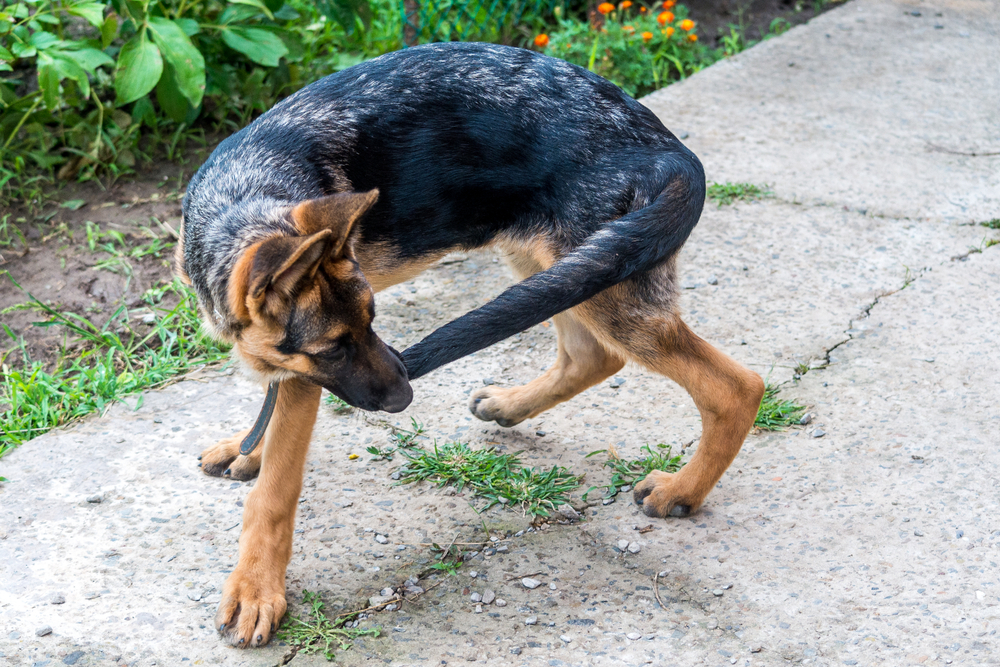Why do dogs chase their tails? Perhaps they know it’s the quickest way to melt our hearts. Or maybe they’re trying to become the social media star they were born to be!
The truth is, this silly-looking behaviour has some harmless reasons, but it could also be a sign of something more serious. If, for instance, you or your trusted Pet Sitter have noticed an increase in tail-chasing or obsessive fixation on their tail, some changes might be in order.
So, as Pet Owners, it’s a good idea to familiarise ourselves with potential root causes of the tail-chasing habit.

Why do dogs chase their tails and what should you do about it?
There are many reasons why a dog might turn snoot to tail for a tail-chasing session. Here are some of the most common reasons, and potential solutions:
Puppyhood curiosity
Puppies explore the world through their mouths. It’s a life stage that Puppy Owners dealing with the biting phase are well familiar with. And, when puppies are young enough not to realise that the furry, wagging thing behind them is their own tail, they may try to investigate with their teeth.
After one or two (or several, depending on the pup!) painful experiments, puppies typically learn that that blur of fur is their own. From there, they may stick with the behaviour because they find it fun.
So, what should you do about it? Well, at this age, it’s not something to worry about. Most puppies have short attention spans and will move onto the next exciting activity before doing any damage to their tails. And as they grow up, most ditch the habit entirely.
Boredom or separation anxiety
Adult dogs who chase their tails may be doing so out of boredom or loneliness. Unlike puppies, they can recognise that the tail is theirs. But, there’s something satisfying, stimulating, or comforting about the behaviour.
If you notice through a doggy cam that your dog chases their tail when they’re alone, there’s a good chance that tail-chasing relieves some tension, boredom, or anxiety.
There are a few ways to deal with the behaviour in this situation. If your dog is bored, you might increase their daily exercise, swap out their old toys for some new ones, or arrange for an experienced Dog Walker to provide them with some company while you’re gone.
Providing your dog with more mental stimulation is another good way to decrease boredom. Puzzle toys and at-home scavenger hunts are fun and mentally challenging. Even switching out their dry kibble for fresh, flavourful dog food can give them an exciting sensory boost at every meal.
When it comes to loneliness or separation anxiety, desensitisation can help, as well. Puzzle toys are a good way to take your dog’s mind off of being alone, but in severe cases, you might need to work on building up your dog’s tolerance to being alone. This includes short absences followed by praise and tasty dog treats. As your dog gets more comfortable, you can increase the time without worrying about your dog chasing their tail or devouring your furniture.
Overexcitement
Maybe you’re familiar with this scenario: you’ve planned a relaxed dinner party with friends. But no matter how much effort went into creating a calm atmosphere, no-one can focus on the food or conversation because your dog is chasing their tail all over the house.
It could be that your dog is so excited to meet new people that they don’t know what to do with themselves. With engines fully revved and a wagging tail to chase, they just go for it.
Overexcitement may also be causing your dog to jump up on your guests, bark, pee on the floor, and a range of other behaviours. And, it will take some desensitisation to help them settle down when they meet new people.
You may be able to help by exercising them immediately before having guests over, providing them with some distracting toys or chews, and rewarding them for calm behaviour.
Attention-seeking
Despite our best intentions, we sometimes unknowingly reward tail-chasing behaviour. Our puppers start chasing their tails and we can’t help but take out the phones, call our family members over, and smile at our charming tail-chaser.
Unfortunately, our doggos are great at making positive associations. We give them our attention when they enact a certain behaviour, and they’ll re-enact the behaviour again and again to get our attention.
In some cases, our pups don’t even seem to mind if the attention is negative! You might tell your dog to stop chasing their tail, but still, they feel a jolt of happiness that comes from interaction with their favourite human.
So, does this mean that you should write off your dog as an overdramatic attention hog? No! At the end of the day, your doggo has good intentions. They want your attention, love, and approval because you’re the best part of their day.
But, you also don’t want to create a situation in which your dog demands your attention with their tail-chasing dance. That’s an example of your dog conditioning you!
Instead, you might work in a few more opportunities for one-on-one interaction throughout the day. That way, you can satisfy your pup’s desire for quality time. And when they do their tail chasing bit? Simply ignore them. Eventually, they’ll realise that they’ll get your attention on your terms.
Itchiness or pain
If your vet has ever sent your pupper home with a dog cone or inflatable collar, you know it’s because dogs have a tendency to chew, lick, or bite themselves. It’s a way to alleviate pain and discomfort, and can be a reason for your dog’s tail-chasing behaviour.
But why the tail, specifically? Well, we hate to get too graphic, but sometimes fleas and other parasites will target your dog’s hard-to-reach places. Tapeworm and other internal parasites may also show up around your pup’s bum. If this is the case, you’ll notice your dog not only chasing their tail, but also scooting around and testing out their flexibility to get to the itchy culprits.
Make sure to stay up-to-date on your dog’s flea and parasite medication and get them to the vet if you think their tail-chasing behaviour is pest-related.
Old age
If your senior dog is chasing their tail, you might consider it to be a burst of puppy energy. While that is possible, tail-chasing and chewing in older age can also be a sign of cognitive decline.
If your young-at-heart doggo is engaging in this habit, while also showing signs of mental fogginess or forgetfulness, it’s a good idea to have them examined by the vet.
Why do dogs chase their tails: final thoughts
Asking “Why do dogs chase their tails,” is an important question for Dog Owners with a tail-chasing dog. Because, while the behaviour is surely endearing, it can also be the sign of a problem that needs attention. Luckily, a trip to the vet, mental stimulation in the form of games or tasty meals, and some quality one-on-one time is often enough to phase out the behaviour.
And every once in a while, if you catch your happy, healthy dog chasing their tail, don’t be afraid to smile. You’re only human!

